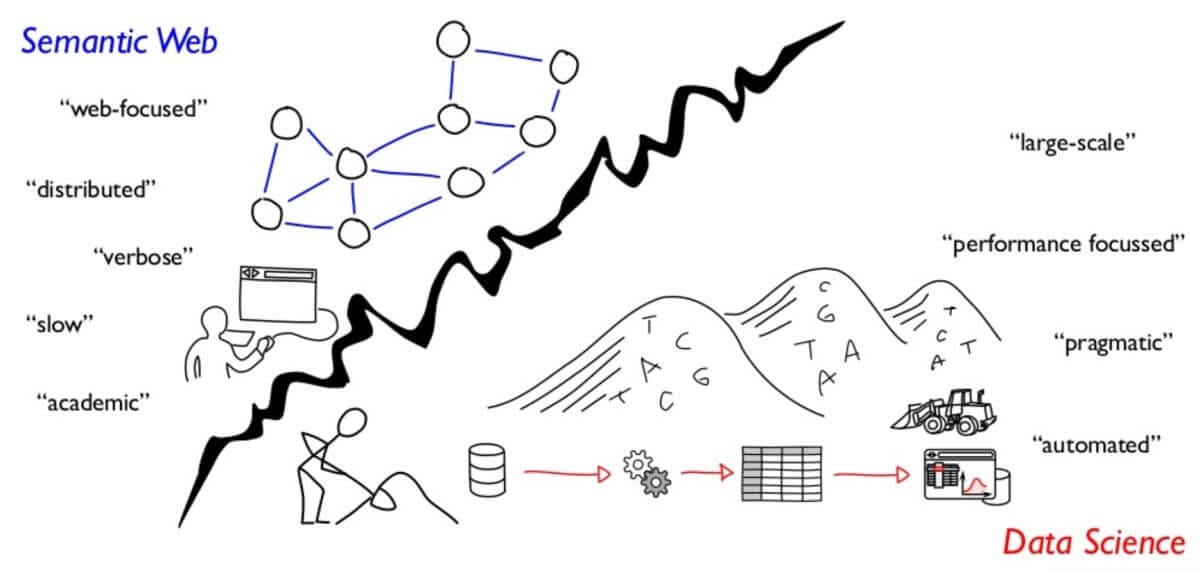Unlock the Power of the Semantic Web | Learn how it’s Revolutionizing Web Technologies
Discover the endless possibilities of the Semantic Web with our in-depth guide. Perfect for people interested in web technologies looking to stay ahead in the digital world. Start exploring today!
Contents
Semantic Web

Semantic Web
Welcome to “sierratech” blog. In this post we will tell about the era of the Semantic Web, a revolutionary paradigm shift that promises to unlock a wealth of opportunities and transform the way we interact with data on the internet. As an expert in this field, I’m excited to share with you the incredible potential of the Semantic Web and how it’s reshaping the digital landscape.
The Semantic Web, a term coined by Tim Berners-Lee, the inventor of the World Wide Web, is a vision for an extension of the current web. It aims to create a web of data that can be processed and understood by machines, enabling more efficient and intelligent information retrieval, integration, and decision-making.
What is the Semantic Web?
The Semantic Web is a web of linked data that is structured and annotated with semantic metadata, making it machine-readable and understandable. This metadata provides context and meaning to the data, enabling software agents and applications to interpret and reason with the information effectively.
At the core of the Semantic Web lies a set of technologies and standards, such as the Resource Description Framework (RDF), Web Ontology Language (OWL), and SPARQL Protocol and RDF Query Language (SPARQL). These technologies facilitate the creation, representation, and querying of semantic data, enabling the seamless integration and interoperability of information across diverse domains and applications. This is closely related to artificial intelligence.
What is the semantic web in simple terms
The semantic web in simple terms is a way of organizing and linking data on the internet in a more meaningful and understandable way for computers. It allows machines to understand the context and relationships between different pieces of information, making it easier to search, analyze, and share data.
Benefits of Semantic Web

Benefits of Semantic Web
The Semantic Web offers a myriad of benefits that are set to revolutionize the way we interact with data and unlock new possibilities across various industries. Here are some key advantages:
- Improved Data Integration: The Semantic Web enables the integration of data from disparate sources, breaking down silos and facilitating seamless data exchange and interoperability.
- Enhanced Search and Discovery: With semantic metadata, search engines can better understand the context and meaning of information, providing more relevant and accurate search results, Its good for SEO.
- Intelligent Decision-Making: The ability to reason over linked data and draw inferences enables intelligent decision-making systems that can support complex scenarios and provide valuable insights.
- Personalized Experiences: By understanding user preferences and context, the Semantic Web can deliver personalized and tailored experiences, enhancing user satisfaction and engagement.
Limitations of semantic web

Limitations of semantic web
The limitations of the semantic web include challenges in data quality and accuracy, the complexity of creating and maintaining ontologies, scalability issues, and the need for widespread adoption and standardized formats for interoperability.
What is OWL in semantic web

What is OWL in semantic web
OWL stands for Web Ontology Language. It is a family of knowledge representation languages designed for authoring ontologies, which are formal descriptions of concepts, relationships, and properties within a specific domain.
OWL is a W3C (World Wide Web Consortium) standard and is used to define and instantiate web ontologies. It is built upon the Resource Description Framework (RDF) and provides additional vocabulary for describing properties and classes, including relations between classes, cardinality, equality, richer typing of properties, and enumerated classes.
OWL is widely used in the Semantic Web to represent and reason about knowledge in a machine-readable format. It allows for the creation of complex ontologies that can be processed and interpreted by computer systems, enabling advanced reasoning capabilities and knowledge inference.
There are three different sublanguages of OWL with varying levels of expressiveness:
- OWL Lite: This is the simplest sublanguage, providing basic features for creating ontologies and defining hierarchies of classes and properties.
- OWL DL (Description Logics): OWL DL is more expressive than OWL Lite and supports maximum expressiveness while maintaining computational completeness (all conclusions are guaranteed to be computable) and decidability (all computations will finish in finite time).
- OWL Full: This is the most expressive sublanguage, providing complete freedom of modeling with no computational guarantees.
OWL ontologies are widely used in various domains, such as life sciences, healthcare, e-commerce, and knowledge management systems, to represent and share domain knowledge in a structured and interoperable way. By leveraging OWL, the Semantic Web enables advanced reasoning, data integration, and knowledge discovery across diverse information sources.
Applications of the Semantic Web
The Semantic Web is already making waves across various domains, and its applications are vast and far-reaching. Here are some notable examples:
- Healthcare: The Semantic Web can facilitate the integration of medical data from diverse sources, enabling better diagnosis, treatment, and research.
- E-Commerce: Semantic technologies can enhance product discovery, recommendation systems, and customer experience by understanding user preferences and context.
- Knowledge Management: The Semantic Web allows for the effective management and sharing of organizational knowledge, facilitating collaboration and knowledge transfer.
- Smart Cities: By integrating data from various sources, the Semantic Web can support intelligent urban planning, resource management, and citizen services.
Use cases for semantic web

Use cases for semantic web
Sierratech team prepare some real-world use cases for the Semantic Web:
1. Enhanced Search and Information Retrieval:
-
Imagine searching the web not just for keywords, but for the actual meaning behind those words. The Semantic Web allows websites to describe their content using ontologies (shared vocabularies) that machines can understand. This enables more precise search results, surfacing the most relevant information for your needs.
-
For instance, searching for “zebra” wouldn’t just return webpages with the word “zebra,” but also pages that describe zebras as black and white striped mammals native to Africa.
2. Improved Data Integration and Interoperability:
-
The Semantic Web facilitates seamless data exchange between different systems and applications. Businesses can leverage this to integrate data from various sources, like customer databases, product catalogs, and financial records. This unified view allows for better decision-making, personalized recommendations, and streamlined operations.
-
Imagine a travel website that integrates data from airlines, hotels, and car rentals. Thanks to the Semantic Web, the website can understand the relationships between these entities and offer users comprehensive travel packages tailored to their preferences.
3. Scientific Research and Knowledge Management:
-
Researchers can utilize the Semantic Web to connect and share scientific data in a structured and interoperable way. This enables faster discovery of relevant research findings, fosters collaboration, and accelerates scientific progress.
-
Imagine a researcher studying the effects of climate change. Through the Semantic Web, they can access and analyze vast datasets on weather patterns, oceanographic data, and environmental impact assessments, all linked and described in a way that facilitates deeper understanding.
4. Smart E-commerce and Product Recommendations:
-
Online retailers can leverage the Semantic Web to offer more intelligent product recommendations. By understanding the relationships between products, customer preferences, and user reviews, the Semantic Web can suggest relevant products that complement each other, ultimately leading to increased sales and customer satisfaction.
-
For example, if a customer is browsing for a new camera, the Semantic Web can recommend compatible lenses, tripods, and memory cards based on the specific camera model and user-generated reviews that highlight complementary features.
5. Enhanced Internet of Things (IoT) Applications:
-
The Semantic Web plays a crucial role in connecting and managing the vast network of devices in the IoT ecosystem. By providing a shared understanding of data and device functionality, the Semantic Web enables seamless communication and collaboration between devices, leading to smarter and more automated environments.
-
Imagine a smart home where connected devices can understand each other. Based on pre-defined rules, your smart thermostat could automatically adjust the temperature when a sensor detects someone entering the room, all thanks to the shared understanding facilitated by the Semantic Web.
The Future of the Semantic Web
As the adoption of the Semantic Web continues to grow, we can expect to witness a transformation in the way we interact with data and information. The future holds exciting possibilities, such as:
- Semantic Interoperability: The seamless integration and exchange of data across diverse systems and platforms, enabling a truly connected and intelligent web.
- Cognitive Computing: The Semantic Web will pave the way for advanced cognitive computing systems that can understand, reason, and learn from data, enabling more sophisticated applications and services.
- Internet of Things (IoT): The Semantic Web will play a crucial role in the IoT ecosystem, enabling the integration and interoperability of data from numerous connected devices and sensors.
- Artificial Intelligence (AI): The structured and machine-readable data provided by the Semantic Web will fuel the development of more powerful AI systems capable of understanding and reasoning over complex information.
As we step into this exciting era, it’s crucial for businesses, organizations, and individuals to stay informed and embrace the Semantic Web. By leveraging its potential, we can unlock new opportunities, drive innovation, and pave the way for a more intelligent and connected future.
Unlock the power of the Semantic Web today and be at the forefront of this technological revolution.



coby kunze
9 May, 2024 7:01 amThis article does a great job of breaking down the concept of the semantic web into easy to understand terms. It’s fascinating how technology is evolving to make information more accessible and connected.
broderick tromp
9 May, 2024 7:01 amI found this article to be very informative and well-written. I appreciate the discussion on how the Semantic Web can improve search engine capabilities and make information more easily accessible. I look forward to seeing how this technology continues to evolve in the future.
marques weissnat
9 May, 2024 7:12 amI found this article to be informative and helpful in understanding the potential limitations of the semantic web. It’s important to consider these factors when implementing semantic web technologies.
hipolito schuppe
9 May, 2024 7:12 amThis article provided a clear and concise explanation of what OWL is in the semantic web. It helped me understand the importance of using OWL for defining relationships and constraints in data.
sandra tillman
9 May, 2024 7:21 amThis article provides a great overview of the practical applications of semantic web technology. It’s interesting to see how it can be used in various industries to enhance data integration and knowledge management.